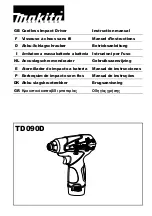
KTI-81798A 3 04/12/16
Drain Daily
Regulator
Oiler
Quick Coupler
Leader
Hose
Nipple
Do Not Install
Quick Coupling
Here
Nipple
Filter
Air Supply
Whip Hose
AIR SUPPLY
Tools operate on a wide range of air pressures. It is recommended that air pressure measures 90 psig at the tool with the trigger fully depressed and
no load applied to the tool. Higher pressure (over 90 psig; 6.2 bar) raises performance beyond the rated capacity of the tool, which will shorten tool
life and could cause injury.
Always use clean, dry air. Dust, corrosive fumes, and/or water in the air line will cause damage to the tool. Drain water from air lines and compressor
prior to running tool. Clean the air inlet filter screen weekly. The recommended hookup procedure can be viewed in the below figure.
The air inlet used for con nect ing air supply, has stan dard 1/2" NPT American Thread. Line pressure should be increased to compensate for unusually
long air hoses (over 25 feet). Minimum hose diameter should be 1/2" I.D. Fittings should have the same inside dimensions and should be tightly secured.
Ensure an accessible emergency shut off valve has been installed in the air supply line and make others aware of its location.
LUBRICATION
Lubricate the air motor daily with high quality air tool oil. If no air line oiler is used, run 1/2 oz. of oil through the tool. The oil can be squirted into the
tool air inlet or into the hose at the nearest connection to the air supply, then run the tool. A rust inhibitive oil is acceptable for air tools.
After an air tool has been lubricated, oil will discharge through the exhaust port during the first few seconds of operation. The exhaust port must
be covered with a towel before applying air pressure to prevent serious injury.
TROUBLESHOOTING
Other factors outside the tool may cause loss of power or erratic action. Reduced compressor output, excessive drain on the air line, moisture or
restrictions in air pipes or the use of hose connections of improper size or poor conditions may reduce air supply. Grit or gum deposits in the tool
may cut power and may be corrected by cleaning the air strainer and flushing out the tool with gum solvent oil or an equal mixture of SAE #10 and
kerosene. If outside conditions are in order, disconnect tool from hose and take tool to your nearest authorized service center.
OPERATION
This tool is an impacting tool and not a torque meter. When specific torque is required, it must be checked with a torque meter after fitting the fastener
with the Impact.
If a fastener does not move within five seconds, use a larger size Impact. Do not use Impact Wrench beyond rated capacity, as this can drastically
reduce the tool life.
NOTE: During operation, safety goggles must always be worn to guard against flying debris (users & bystanders).
Always turn off the air supply, drain hose of air pressure and detach tool from air supply before installing, removing or adjusting any part or
accessory on this tool, or before performing any maintenance on this tool.
NOTE:
Actual torque on a fastener is directly related to joint hardness, tool speed, con di tion of socket and the time the tool is al lowed to impact.
Use the simplest possible tool-to-socket hook up. Every con nec tion absorbs energy and reduces power.
WARNING
































